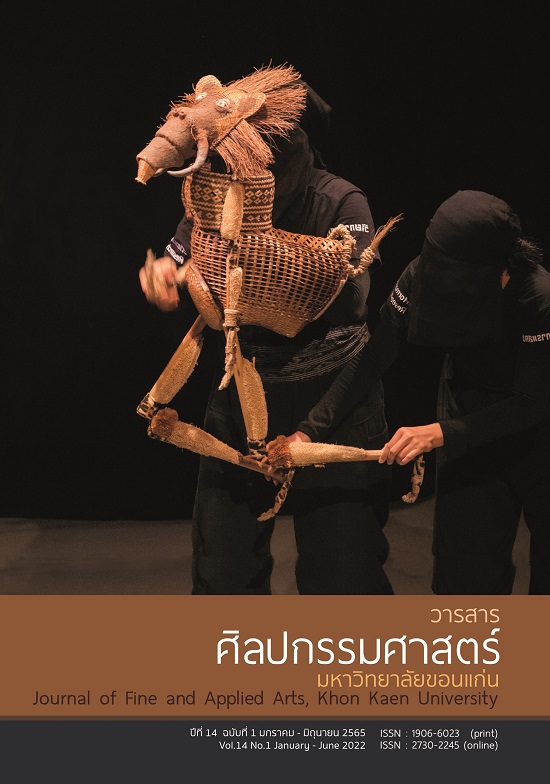The Pidan: The Creation of Thai Contemporary Folk Dance from Belief in Pidan Textiles
Main Article Content
Abstract
This article is aimed to create the contemporary folk dance from belief in PIDAN textiles. There are steps from researching that lead to thinking processes, developing and creating neatly exceptional works and procedures to implement educational methods. Data article was analyzed and used as a guidance to create the contemporary folk dance which the principle idea comes from the Khmer culture and their cultural heritage of weaving from the ancient. A type of weaving is called “PIDAN textiles”. It is the fabric woven for offering to Buddha, woven with a Mudmee. The patterns that appear are stories about Buddhism, by using it to attach the celling over the image and hang at religious places. In this beautiful creation, there is a form of acting to present to a woman who is weaving with love, expectation, time, emptiness, heaven ritual, industriousness, and the dedication of weaver. The creation of this show uses the creative theory according to the step which are the idea of artistic dance, determination of concept, data processing, define scope, configuration, defining other elements, the design of artistic dance and evaluation of posture design, movement, music, showing equipment and costume. The traditional culture of ancient Khmer people in Thailand was used in creating show elements. In addition, this show is presented to the experts for evaluation and to improve the creation of showing for next time.
Article Details

This work is licensed under a Creative Commons Attribution-NonCommercial-NoDerivatives 4.0 International License.
Content and information in articles published in the Journal of Fine and Applied Arts of Khon Kaen University is regarded as the opinion and sole responsibility of the author(s) directly; therefore, editors are not obliged to agree to or share any responsibility with regard to the content and information that appears within these articles.
All articles, information, content, image, etc. that have been published in the Journal of Fine and Applied Arts of Khon Kaen University is the copyright of the Journal of Fine and Appllied Arts of Khon Kaen University. Any person or organization who wishes to distribute all or parts of the articles for further dissemination or other usage must first receive permission from the Journal of Fine and Applied Arts of Khon Kaen University before proceeding to do so.
References
ฑะฌัน จันทรุพันธุ์, และชาติชาย พรหมจักรินทร์. (2521). พจนานุกรมเขมร (สุรินทร์) - ไทย - อังกฤษ. กรุงเทพฯ : โครงการวิจัยภาษาไทยและภาษาพื้นเมืองถิ่นต่าง ๆ สถาบันภาษาจุฬาลงกรณ์มหาวิทยาลัย.
ธีรพันธุ์ จันทร์เจริญ. (2547). มัดหมี่มัดใจ สายใยวัฒนธรรมเขมร ลาว ไทย. กรุงเทพฯ : มูลนิธิเจมส์ เอช ดับเบิลยู ทอมป์สัน.
ปฐม หงษ์สุวรรณ. (2558). ผ้าทอในวิถีชีวิตไทย-ไท. กรุงเทพฯ : สถาบันไทยศึกษา จุฬาลงกรณ์มหาวิทยาลัย.
ปิยะพร กัญชนะ. (2563). วันเวลาของผ้าไทย: รัก หวง ห่วง ตามประสา. กรุงเทพฯ : พลัสเพรส.
เผ่าทอง ทองเจือ. (2558). สมปักปูมภูมิผ้าเขมร-ไทย จากราชสำนักสู่สามัญชน. กรุงเทพฯ : เนติกุลการพิมพ์.
ศิริ ผาสุก. (2536). สุรินทร์ มรดกโลกทางวัฒนธรรมในประเทศไทย. กรุงเทพฯ : เอส แอนด์ จี กราฟฟิค.
ศูนย์ส่งเสริมศิลปาชีพระหว่างประเทศ. (2561ก). ความรุ่มรวยแห่งภูมิปัญญาอีสานใต้. พระนครศรีอยุธยา : ศูนย์ส่งเสริมศิลปาชีพระหว่างประเทศ.
ศูนย์ส่งเสริมศิลปาชีพระหว่างประเทศ. (2561ข). ความวิจิตรแห่งศิลปะไทย กลุ่มทอผ้าไหมยกทองจันทร์โสมา บ้านท่าสว่าง จังหวัดสุรินทร์. พระนครศรีอยุธยา : ศูนย์ส่งเสริมศิลปาชีพระหว่างประเทศ.
สิทธิชัย สมานชาติ. (2557). “โฮล” และ “ปิดาน” : มรดกสิ่งทอเขมรในภูมิภาคอาเซียน. วารสารศิลปศาสตร์ มหาวิทยาลัยอุบลราชธานี, 10(1), 109-122.
สิทธิชัย สมานชาติ. (2562). มรดกภูมิปัญญาสิ่งทออีสาน. กรุงเทพฯ : โรงพิมพ์ชุมนุมสหกรณ์การเกษตรแห่งประเทศไทย.
สุรพล วิรุฬห์รักษ์. (2547). หลักการแสดงนาฎยศิลป์ปริทรรศน์. พิมพ์ครั้งที่ 3. กรุงเทพฯ : สำนักพิมพ์แห่งจุฬาลงกรณ์มหาวิทยาลัย.
Green, G. (2008). Pictorial Cambodian textiles. Bangkok : River Books.
McIntosh, L. (2007). Weaving paradise Southeast Asian textiles and their creators. Bangkok : River Books.


